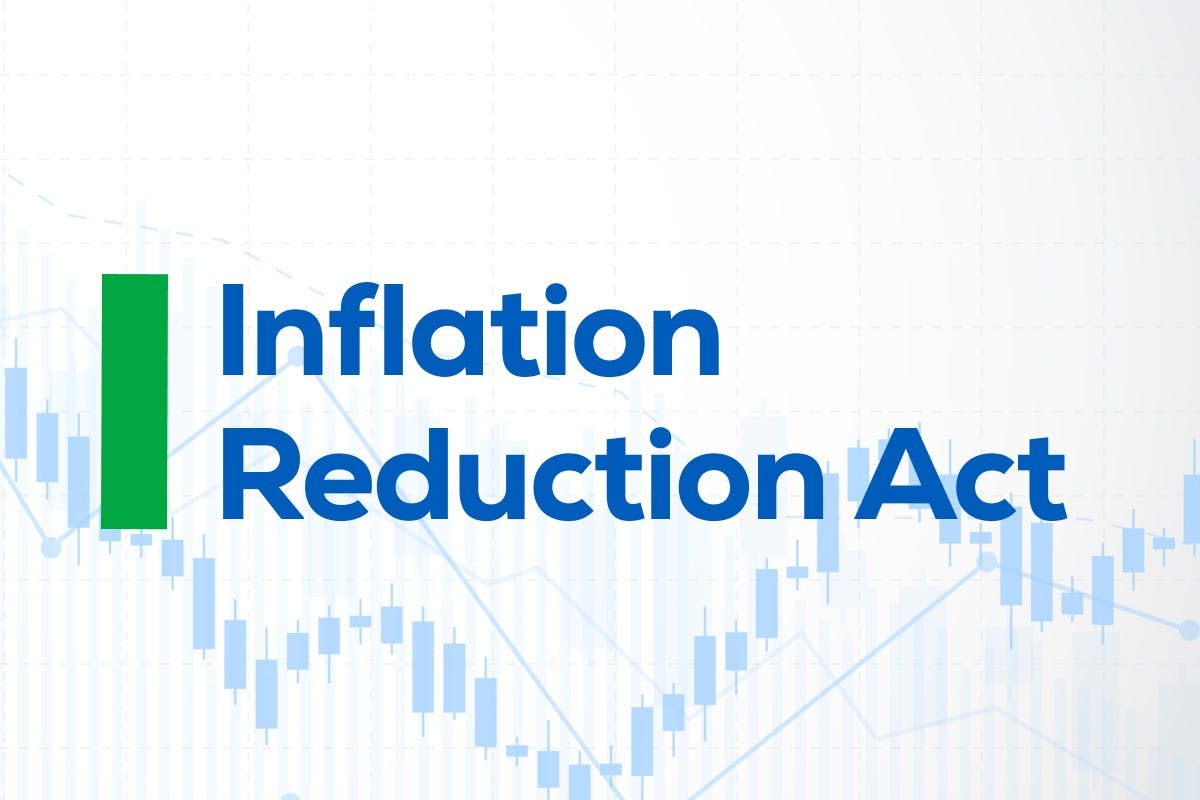When the US government wants more of something, it often turns to tax credits. The same is true for solar power and renewable energy. While some sort of tax credit for solar has existed since 2005, enacting the Inflation Reduction Act in 2022 kicked them into overdrive. From now to 2032, if you purchase solar panels for your home, you likely can claim 30% of the project cost as a credit on your income taxes.
But solar panels aren’t the only thing that can earn you a tax credit and tax credits aren’t the only incentive available. We’ll demystify all the incentives the Inflation Reduction Act introduced for homeowners and how you can claim them to help you save money by making your home more energy efficient and resilient.
See how much you can save by going solar with Palmetto
What Is the Inflation Reduction Act?
The Inflation Reduction Act of 2022 is a piece of legislation that invests $369 billion towards clean energy and energy security, representing the largest investment in U.S. history towards the goal of combating climate change. The bill uses tax credits to incentivize the installation of solar power and battery storage systems and rebates for electrifying the home to reduce fossil fuel usage.
The bill was signed by the Senate on August 7, 2022, and then signed by the House of Representatives on August 12, 2022, and was signed by President Biden on August 16, 2022.
What Does the Inflation Reduction Act Mean for Solar Panels?
For home solar power, the Inflation Reduction Act increases the Investment Tax Credit for residential solar systems to 30% and extends the program through December 31, 2034, creating a decade of predictable tax savings. (The bill renames the Investment Tax Credit to the more obvious Residential Clean Energy Credit.)
(For more information about the Investment Tax Credit (ITC), check out our guide: Everything You Need To Know About The Solar Tax Credit)
In addition, the 30% tax credit now extends to battery storage systems, even if those systems are added after the solar panels have been installed on the roof. This solar battery storage tax credit can significantly reduce the cost of adding storage for energy security and backup power.
As a result of this solar tax credit extension, the Inflation Reduction Act is expected to help cut up to 1 billion tons of carbon dioxide emissions, reducing carbon and greenhouse gas (GHG) emissions by roughly 40% by 2030, according to a study by Zero Lab at Princeton University.
Value of the Solar Tax Credit
After the passing of the Inflation Reduction Act of 2022, the value of the solar tax credit is as follows:
- 30% - Projects that finish construction between 2022 and 2032
- 26% - Projects that finish construction in 2033
- 22% - Projects that finish construction in 2034
- 0% - Projects that finish construction in 2035 or later
This value is based on the total cost of the system, including parts, labor, and permitting.
For any system installed in 2022, even if it was installed before the Inflation Reduction Act of 2022 passed, that system will be eligible for the full 30% tax credit during your next yearly tax filing.
See how much you can save by going solar with Palmetto
History of the Solar Tax Credit
The Investment Tax Credit was originally created by the Energy Policy Act of 2005, and has changed value (and nearly expired) many times over the years.
Most recently, the value of the solar tax credit was 30% in 2021, before changing to 26% in 2022, and was set to change again to 22% in 2023, before expiring entirely in 2024.
Thanks to the Inflation Reduction Act Of 2022, that deadline has now been extended through 2034, which represents the single most significant federal investment to decarbonize the sectors responsible for the nation’s greenhouse gas emissions - transportation, electricity generation, and residential, commercial, and industrial energy use.
“The United States is poised to lead the world’s clean energy transformation while lowering costs for families.”
Abigail Ross Hopper
President and CEO, Solar Energy Industries Association (SEIA)
How Is the Inflation Reduction Act Being Funded
Changes being enacted by the bill are expected to generate $739 billion, with $300 billion being invested into deficit reduction. This funding comes from a variety of sources:
- 15% corporate minimum tax
- Prescription drug pricing reform
- IRS tax enforcement
- 1% stock buybacks fee
- Loss limitation extension
Other Products With Tax Credits and Rebates
The Inflation Reduction Act also created a slew of other tax credits and set aside money for additional rebates to help decarbonize homes and commercial buildings, generate alternatives to fossil fuels (like hydrogen), and jumpstart manufacturing for things like solar panels within the United States.
Here are the tax credits and rebates that can help reduce or clean up your energy use at home.
Energy Efficient Home Improvement Credit
The Energy Efficient Home Improvement Credit lets you claim 30% of some home improvement projects as a tax credit. This specific credit has a $1,200 yearly limit and there are some limits for individual improvements, but there’s no lifetime limit.
| Item | Per limit item | Annual Limit |
|---|---|---|
| Home energy audit | $120 | $120 |
| Doors | $250 | $500 |
| Windows and skylights | $600 | $600 |
| Insulation | $1,200 | $1,200 |
| Air conditioners | $600 | $1,200 |
Heat pump tax credit
There’s a separate tax credit for heat pumps, which can cover 30% of your project costs, up to $2,000.
Rebates for energy-efficient appliances and projects
The rebates established by the Inflation Reduction Act are a bit different. While the tax credits are run by the federal government and available to anyone who pays federal income tax, the rebates will be distributed through programs run by the states and eligibility restrictions may apply.
As of this writing, only New York and Wisconsin have received approval for their rebate programs. Eight other states have had their programs approved and should have rebates available soon.
According to the Inflation Reduction Act, households that earn up to 80% of the median income in their area can claim the full rebate, up to a maximum of $14,000 in total rebates, through Sept. 30, 2031. (You can assess median family income for your area at the Office of Policy Development and Research.)
For moderate-income households, defined as earning between 80% and 150% of their area’s median income, they can receive the same rebates, but the value is capped at no more than 50% of the total cost of the project.
Each state can limit their programs in other ways, including lowering the eligibility requirements or rebate maximums. Be sure to double check your state’s program before counting on a rebate.
There is a maximum of $14,000 in total rebates you can claim. The amounts listed below are the maximums allowed for in the Inflation Reduction Act.
| Item | Rebate amount |
|---|---|
| Electric heat pump clothes dryer | $840 |
| Electric stoves, cooktops, and ovens | $840 |
| Electric heat pump | Up to $8,000 |
| Electrical panel upgrade | Up to $4,000 |
| Electrical wiring upgrade | Up to $2,500 |
| Heat pump water heater | Up to $1,750 |
| Induction cooktops | $840 |
| Insulation, air sealing and ventilation | $1,600 |
The rebate on electrical system upgrades is especially important to those considering home solar, as they are often necessary before solar panels or battery storage systems can be installed, so this can definitely help lower the overall cost of a project when installing solar.
The Home Efficiency Rebates are also not yet available but will be available for projects that are determined to lower energy consumption by a certain percentage.
| Energy efficiency project | Rebate amount |
|---|---|
| Projects reducing energy consumption by 20% | Up to $4,000 |
| Projects reducing energy consumption by 35% | Up to $8,000 |
How To Take Advantage of the Inflation Reduction Act
If you’ve been thinking about going solar to help offset the rising cost of electricity, t now may be a great time. This extension of the solar tax credit provides meaningful stability to the residential solar industry and companies like Palmetto.
Thanks to the Inflation Reduction Act Of 2022, projects that install in 2022 and beyond are now eligible for a 30% tax credit, which can significantly lower the cost of installing solar panels.
To find out how much you can save, get started today with our free Solar Design and Savings Estimate tool. With just a few pieces of information, we can show you what a solar power system would look like on your roof, calculate your estimated cost and potential 30-year savings, identify the environmental impact of your decision to go solar, and more.
Frequently Asked Questions
How do you get rebates from the Inflation Reduction Act?
Along with the tax credits that the Inflation Reduction Act puts into place, there is money that will be set aside for rebates for home energy efficiency and energy efficient appliances. These rebates will be administered by the states, which are now getting their programs approved by the federal government. So far, Wisconsin and New York have had their programs approved.
Do I qualify for Inflation Reduction Act tax credits and rebates?
You should always consult with your own tax advisor with questions like these, but as long as you pay federal income taxes and your equipment meets the criteria laid out in the tax code, you should qualify. The rebates laid out in the Inflation Reduction Act will be paid out by the states. Specific eligibility requirements will be determined by them.
Are there rebates for heat pumps?
The Inflation Reduction Act established a tax credit for heat pumps worth 30% of the project costs or $2,000. It also set aside money for a rebate that can be worth up to $8,000, depending on your state’s eligibility requirements for applicants.
See what solar can do for you:
Disclaimer: This content is for educational purposes only. Palmetto does not provide tax, legal, or accounting advice. Please consult your own tax, legal, and accounting advisors.
 Cory O'BrienSenior Director - Growth Marketing
Cory O'BrienSenior Director - Growth MarketingCory brings over 8 years of solar expertise to Palmetto, and enjoys sharing that knowledge with others looking to improve their carbon footprint. A dog lover residing in Asheville, NC with his wife, Cory graduated from UCSB. If you run into him, ask him about the company he founded to rate and review beer!

